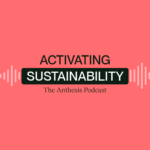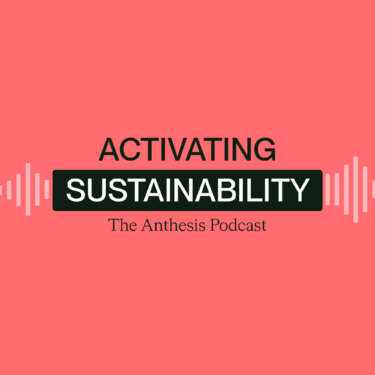
Speakers
Chris Peterson – Director
Cassandra Martynow – Director
Related Topics
Share this episode
In this episode of Activating Sustainability, our host Chris Peterson is joined by Director Cassie Martynow and Toby Parker to discuss mandatory climate reporting, such as the Corporate Sustainability Reporting Directive (CSRD), SEC, and European Sustainability Reporting Standards (ESRS).

Read the transcript
Chris: Hello and welcome to Activating Sustainability, the Anthesis podcast. I’m your host Chris Peterson. Today we’re tackling mandatory reporting, which has shifted in surprising and important ways. I should say we’re recording this at the end of October ahead of SEC’s decision on climate disclosure, which is likely to throw even more fuel on this growing fire.
To help unpack the issues and opportunities, I’m joined by two leaders of our mandatory reporting practice, Cassandra “Cassie” Martynow, Director of ESG and Sustainability Strategy, and Tobias “Toby” Parker, Director of Climate Risk. Welcome to the podcast. Thanks so much for doing this.
Cassie: Thanks for having us.
Toby: Thank you. Good to be here.
Chris: So let’s jump into it and could you help us to understand what is mandatory reporting?
Cassie: So mandatory reporting is kind of a funny term. I mean when we say mandatory reporting what we really mean is mandated reporting and in this particular case regulated reporting specifically.
But the thing is that like regulated reporting has been around for a long time. Um, and, and yes, includes things that we now consider ESG metrics, right? You have like conflict minerals reporting, you have reporting on hazardous substances and different materials. Um, we even got some, you know, you’ve got reporting to cap and trade programs that our GHG team does, things like that.
The reason people keep talking about mandatory reporting right now is I think because there’s been a fundamental change in The scope and scale of what counts as mandatory reporting, you know, in the U. S. if you’re looking at things like The SEC’s proposed Climate Disclosure Rule, or, um, the two bills that California just, uh, signed into law.
The scale of who falls under that mandatory reporting regulation is much larger, um, than we’ve, than anything we’ve really seen before, right? The SEC will apply to all publicly listed companies in the U. S. with some variations, you know, for timeline, depending on size of company. California is, is, uh, you know, companies over a certain size.
Public or private that do business in California. And then when you look at the EU and you look at things like the CSRD, the Corporate Sustainability Reporting Directive, the scope of what is included is so much larger than what we’ve seen in the past, right? Yes, it’s based on materiality, in this case double materiality, so not everyone’s going to report on everything.
But for the first time, there is an actual regulated requirement to determine if things like biodiversity and nature loss are relevant to your company, pollution, you know, impacts on water and marine resources, things like that. And then actually report those out transparently to all of your different stakeholders.
And I think that is, so when people say mandatory reporting right now, they’re thinking of things like the CSRD Whereas this for, for me, I see this as a significant expansion in what mandatory reporting on ESG metrics has meant.
For some time
Chris: and what are the general objectives of these kind of emerging regulations and where that’s shifting?
Toby: Yeah, I’ll have a go at that. Um, it’s a really interesting question because there’s a kind of what is mandatory reporting and then what is it for? And, and I suppose what it’s trying to do is to drive some accountability.
Um, when we look at other forms of mandatory reporting, so, you know, every year companies have to publish their, their accounts, their audited. They put out into the marketplace and that, that is intended to drive behavior, fundamentally accountability on the business side, useful information out to investors and other stakeholders.
And so that is meant to keep businesses noses clean fundamentally. And I think when you apply that same principle to, uh, some of these metrics that we’re now getting into, again, it’s designed to, to drive accountability in the business for effectively keeping their performance. pointing in a good direction.
And so you’ve got to ask yourself, why is that right? So the reason why it’s coming through and the reason why it’s being mandated by governments is that governments are seeing some pretty nasty stuff coming over the horizon. And so what they’re effectively doing, and that’s because they’re keeping their eyes on the science, right?
The science is telling us that there’s some bad things coming. And of course, organizations tend to have relatively short time horizons of three years, three to five years can feel like a long time in many organizations sort of forward view. And so some of these regulations and reporting requirements are really designed to get organizations thinking a bit more holistically and also thinking a bit more longer term.
So the field in which I’m occupied is climate risk. And so we’re looking at much longer time horizons, pushing our view out to 2050, which is significantly longer than many organizations typically think, but it’s really important because when we’re seeing what the science is telling us. That’s not a great place that we’re heading into.
And so from a business perspective, from an investor perspective, from other stakeholders perspectives, we’ve got to really understand how organizations are thinking and shaping themselves up to be not just surviving, but really thriving in those future, future events. So that’s the kind of what it’s for.
But Cassie, any thoughts on that?
Cassie: I think that’s true. And I think it’s accountability plus comparability, uh, for lack of a better word, right? Like the, the SEC chair, Gary Gensler is as mentioned specifically that we have a lot of voluntary reporting on this stuff already, right? You have a lot of companies that are already either leading or somewhere on the spectrum of voluntary reporting on a lot of these metrics, but because there’s no infrastructure around it and there’s no regulation, you have to rely on basically a willingness to
conform specifically to the existing voluntary frameworks and standards. And like, you know, even GRI, if you, if you pick 10 reports, you’ll probably get 15 different versions of the application of the GRI framework in the back. Right. So I think that part of this is about enforcing a mechanism that allows investors, customers and other stakeholders to actually take two reports by two companies in the same industry and understand relative to each other, who is actually doing what’s necessary and who has maybe been saying they’re doing what’s necessary, but really isn’t because they’ve been fudging the numbers or using different units or that kind of like little wild west version of voluntary reporting.
Toby: Yeah. Yeah. And I guess that’s, that’s why we’re seeing, well, that’s an angle that there’s been a lot of pushback on because creating sort of rigorous standards and the more you peel the onion on what’s being required to report on, the more you realize the levels of complexity, um, that actually confront us.
And so creating something which, um, allows that comparability is, is difficult, and so certainly there are lots of organizations and lots of lobbyist groups that don’t want to go down this route. And so they’re seeing that as a route to just delay things and slow it all down. But, you know, you’ve got to start somewhere, right?
You’ve got to start somewhere. So even though we, we will need to evolve this, you know, businesses that we’re dealing with. On the climate risk side. Um, most of them have never really thought about climate risk. And so they’re not prepared to, you know, even in that sort of mental space, introducing concepts around risks that they’ve never really confronted before.
There’s a long way to go. So the systems that are being pointed towards within these frameworks are still at a relatively early stage. There’s a lot of refinement going on.
Chris: It certainly feels that way, just hearing from you both in terms of like what you’re tracking and what’s coming and the news, etc. It seems to be just this like evolving space, but it does seem to be tracking towards kind of a more consistent outcome than we’ve seen in the past.
Right where there were kind of these like shots across the bow in the past, but this seems to be gaining some traction I’d be curious to hear as you both are looking globally How do you see this kind of playing out in different areas or how is that kind of manifesting?
Cassie: So we’re seeing what you would expect right, is that the the strictest versions of the rules are being proposed and implemented in the EU and Um, and there’s a little bit of a trickle down effect across the globe, right?
So, you know, what the SEC is proposing and even what, um, California has implemented or approved, those are a subset of what’s happening in the EU. There are other things. I think we focus a little too heavily on the EU and North America. Um, in a lot of the conversations about mandatory reporting these days, because there’s actually a lot of movement happening in the APAC, sort of Asia Pacific region.
It’s more focused on the ISSB’s framework, right? Which is, people haven’t really been paying attention to that so much because it’s voluntary. But, the, uh, the ISSB has said something like 30 countries have committed to implementing it as mandatory. And, I, I think what a lot of people are going to get caught off guard by is that.
They do have subsidiaries in places like Singapore, Malaysia, Australia, New Zealand, uh, you know, and like that’s where they’re already making strides to implement the IFRS S1 and S2 standards in the financial reporting for companies throughout the APAC region. There’s been a lot of commitment to aligning with this single
standard, which is for climate related risks and sustainability related risks. And I think that that is. To me, that is one of the most interesting things, right? It’s, it’s become somewhat normal for like the EU to propose big policy change and then eventually the U. S. kind of comes around and thinks about some policy change in that space.
But, um, there’s sort of this like quiet. I see change happening in the APAC region that I am particularly interested in. Um, or we’re watching that closely over time.
Toby: Yeah, I, I’d agree with that. It’s, um, by the way, is an absolute alphabet spaghetti thing, you know, maybe, maybe we can do a, I don’t know, a sort of library of all these four letter, three letter acronyms, but certainly ISSB it’s interesting that ISSB is bringing TCFDs
framework underneath it. So there’s some, some kind of convergence alignment and consolidation, um, happening there. And even though the two were kind of related, it’s, it’s good to see that that that’s being consolidated. I guess what we want to avoid is maybe this, this ages me somewhat, but the sort of beta max VHS kind of situation where you’ve got, you know, you’ve got different standards.
Developing in different regions. And what we need is a sort of golden thread, as it were, that we’ve through it, from our client’s perspective, you know, you’re collecting a set of data that you can use through multiple channels and in multiple reporting frameworks. So I guess we’ve seen CDP, you know, over the last few years, really try and
maybe out of sort of an existential need, trying to align itself more to some of these emerging standards. So, yeah, I mean, we’re looking more and more ISSB. More and more clients are becoming familiar with it. We can help them by educating them as to what is Well, The similarities and what are the differences between some of these other frameworks, such as TCFD, but the reality is, you know, we’re, we’re staying on top of it.
We’re having to, you know, swim hard, stay on top of it. There is a, there are many, many technocrats out there thinking about these things coming up with standards. And so it’s up to us to swim hard, you know, do the, do the hard yards and, uh, stay on top of what’s going on there.
Chris: Well, and maybe picking up on that as a terrible speller, the acronyms scare the bejesus out of me and would love to hear from you both terms of like, what are the ones that you feel are really kind of critical to track that you’re keeping a close eye on ISSB. What is that kind of, what do we need to pay attention to, et cetera would be really helpful. And what are your two, two or three favorite acronyms?
Cassie: I uh, so I mean the C-S-R-D-I would say is the big one, right? The Corporate Sustainability Reporting Directive, that’s the EU one. The trouble is that ESRS is also part of that, so the, you have the CSRD is the overarching directive, but then the European Sustainability Reporting Standards ESRS are the general two general standards and 10 topic specific sector agnostic standards that underpin the CSRD.
And CSRD has some additional requirements, but that’s, that’s where you’re tracking materiality against is, is the ESRS under it. I would say that one is probably my top. People have started using just SEC as a reference to, um, uh, the proposed climate disclosure rule in the US. That, to me, gets a little bit confusing because ISSB, the International Sustainability Standards Board, which has developed the, what is, what is even IFRS, International Financial Reporting Standards, I think, and then, uh, S 1 and S 2 are, are the two existing ones in there.
The problem is… Those standards are getting implemented by the SECs of many other countries, right? Like, everybody has a Securities and Exchange Commission. So, that one gets a little bit fuzzy for me. The shorthand of just California is like, well, that, you know, that could refer to a bunch of different things, because California also has a history of, you know, like, environmental related legislation.
But, um, right now it refers to… Oh, here’s another one for you. SB253 and SB261, which just means Senate Bill 253 and Senate Bill 261, which are the GHG emissions and the, oh man, I just did it again. GHG emissions, greenhouse gas emissions and climate risk.
Chris: That’s great. Appreciate it. Yeah.
Toby: Do you remember whiteboards that you could draw things on?
I can, that’s what we need to describe this. It is, um, yeah, it’s really messy. I mean, I think the one, the one that we’re watching, so yes, you got the California bills, the Senate bills that are going through. So again, from the climate risk perspective, um, SB 26, 261, that pretty much points at a TCFD, which is going on the ISSB.
that’s quite nice, nicely wrapped up. We think and hope that that’s going to be become the kind of standard for a lot of serious businesses in in North America in the States, right? Because, uh, the barriers are relatively low. Thresholds are relatively low, certainly from the climate risk side, 500 million worth of business.
So, you know, a lot of businesses are caught up in that still some nuances around what it means to be. I forget the exact words like doing business in California, but you know that that will come out. It just all this is doing is it’s is it’s moving it forward. And, and sometimes it’s a, it’s a kind of like a not marginal, not incremental, but it’s a sort of gentle move forward.
It’s, it’s a move forward. What CSRD was doing is just creating a whole new paradigm, right? And the paradigm that CSRD, um, promises to create is one where not just your financial performance is critical, but also your performance on emissions, on climate, on biodiversity, on social justice, et cetera, et cetera, and and that sort of world where a business’s value is judged on
actually how it’s performing across all these different axes, that’s a different space, uh, to exist in. And so whilst some of these bills are coming through in North America and, uh, associated with ISSB, feel like they’re in, they’re in evolution. CSRDs is like a, a complete, um, transformation. And it’s a huge, it’s a big, big, big step for, um, the world to take.
It’s a necessary step. But it’s just a big step. And so we can expect, um, some, some tumultuous times there, but I’m, I’m, I’m loving the concept of CSRD. I’m really keenly following what’s happening with ISSB in California, for example, and UK’s doing its own, um, something it always does, and then realizes it needs to do something slightly different when everyone else, um, gets there in a slightly better way.
But some of the other markets that we’re seeing a real liftoff in demand for these services in, uh, Spanish business, in our Australian business, in our Nordic business, this is all really starting to, um, to lift the market and, uh, we’re moving towards clients that are at relatively early stages of their journey.
So we’re having to take a very human approach to how we engage with them. A lot of it is providing some comfort that they’re not going to get policed overly aggressively in the early years.
Cassie: I would say, by the way, the emerging alphabet soup that I, um, am most interested in. So Toby has mentioned the TCFD, Task Force on Climate Related Financial Disclosures, and that was originally voluntary disclosure, but has become the framework that underpins a lot of these mandatory disclosures, right?
Because it’s so foundational to the assessment of climate related risks and opportunities. And now we have TNFD, uh, Task Force on Nature Related Financial Disclosures, right? And so I’m interested to see, I suspect over time, we might see the same movement because of how important the conversation on biodiversity and nature loss has become.
So, like, that TNFD is already partially incorporated into some of the other work, uh, like the structures around biodiversity that the CSRD and the ESRS within it have put together, but… I think that would be the one that I would keep a, you know, at least one eye on over time because of how important and how rapidly important that’s becoming.
I would expect to potentially see that become some kind of mandatory framework over time.
Chris: Yeah. Well, and maybe just picking up on your initial point. Cassie, that this, this has existed for a long time. So I’d be curious to hear from the two of you, kind of why now is it important that we care and that we pay attention to it?
Cassie: So it has existed for a long time, but it’s been so specific and it’s been so much about compliance, right? It’s part of the way you do business. You know, you have to do your government mandated reporting on hazardous substances, right? And like, a lot of that for me has been about certain specific aspects like safety, toxicity, some work on, like I said, conflict minerals compliance, things like that.
It’s like addressing very particular issues in the market. I think the reason we should be caring about this now is because… To me, the growth of this, this new version of mandatory reporting. Suggests that we are finally thinking about these issues as interconnected and that you can’t just report over here on conflict minerals.
You can’t just report over here on, you know, the materials you use in your products. You need to think about the intersection of all of these issues across your business and your value chain and your stakeholders and then
think about it, not just as meeting your regulatory requirements for compliance, checking that box, but, If you’re taking the time to look at this across your entire value chain, well then, that should be a trigger for thinking about compliance as a pathway to transformation and ultimately to your impact as a business, right? Like, this is an opportunity to go from making sure you check the box on your specific regulatory requirements, depending on what products you make or what kind of business activities you have, and to, like, A wholesale rethinking of what it means to have impact as a business that is, yes, driven by a particular set of compliance requirements.
Right. But like, if you only care about checking the box on compliance with CSRD. I think you’re going to miss the boat, right? Like that’s, you just, that to me is competitive advantage that you keep is if you think beyond compliance and just use that as a driver to get where you actually want to be in terms of transformation and impact.
Toby: Yeah, that’s that’s um, I agree. I agree with that. I mean, I kind of want to take a step back from the reporting bit because the way I view these frameworks is yes, there is a reporting output. So you’re you’re disclosing what you’re actually doing. It’s interesting when you look at Say ISSB or CSRD, a lot of it is a request to disclose your process.
How are you doing these things? It is less about an output, a figure, you know, it’s useful. How much, you know, what’s your financial position and performance, right? Most of it is about how you’re thinking about these things, how you’re processing. The information that much of which you don’t have. So you’ve got to go and source new information and feed it in.
So that’s interesting that, um, it’s what it’s really trying to do is to, is to shape thinking and behavior within an organization. And so to take a step back from that, why should we care? Here’s some back of the beer map calculations, right? So when we think about mandatory reporting, we put that in the bucket of transition risk.
In risk terms, we say. That’s a transition risk. That’s a kind of risk associated with us moving towards a net zero economy, right? So these are all the things we’ve got to do, all the rules we’ve got to put in place, et cetera, et cetera, things we’ve got to change. And McKinsey have done some calculations and they’ve estimated that come 2020, it’s going to cost us.
Collectively about 9 trillion per year to get to that net zero place. And what that would mean is that actually we’re avoiding the excess costs and damages associated with climate change, right? Net zero economy, minimized costs, still a lot of damage there. If we don’t do that, there’s been other analysis.
For example, Swiss Re 2021. that calculated that about a three degree global heating pathway, which is kind of what we’re on in reality, then that could cost the global economy 18%. 18 percent of our GDP could be taken off through global heating. And other economists have modelled out what the economy could look like, and that’s about 200 trillion come 2050.
Other things held equal, obviously, what that means is a 32 trillion hit to the economy come 2050, when you weigh up the 9 trillion that we’d have to put in to avoid a 32 trillion hit, it seems to make sense. And so, you know, when you, when you look at that and you think, well, you know, why should we care?
Well, that’s our future. That’s the future for investors. citizens, businesses, et cetera, et cetera. So that’s why it’s important because it’s shifting thinking into those sorts of spaces. And we don’t do enough. We don’t do enough thinking about that. We’re sort of going through our day to day quarter by quarter, month by month.
We’re not really thinking about what is coming over the horizon. So that’s kind of the ultimate reason why we should care.
Chris: Yeah. And it, I mean, it’s fascinating to see how much it has changed. And as you both have kind of alluded the value of having some of that being kind of transparent and comparable in the market to support that kind of decision making.
So as individuals sitting within organizations, you know, what would you recommend people do today or tomorrow as they approach this?
Cassie: I mean, the first is to your point about the alphabet soup is education will be my thing. This, this stuff is not easy to understand, right? You know, educate yourself if you’re up for that or, you know, get help, right?
I feel like half of what we do with clients is just sit down and talk through the different standards, different requirements, what it means for their business. How do they interact? The second thing I would see folks in sustainability roles having a little trouble with budgets lately. And like this reporting is going to require a substantial investment of additional time and resources and you know more collaboration across the business and things like that.
And at a time when some people are having their sustainability budgets whittled down, you know, because everyone’s sort of like worried about recession and constantly kind of protecting against that. I say, from a purely mercenary standpoint, like, use this as part of the argument for continuing to hold sustainability budget and continuing to show the importance of that.
I mean, last thing I would probably say is Go into it with clear eyes, you know, uh, because even companies that are very mature in their current voluntary reporting, where we have clients who’ve been doing it for a number of years, even those clients are figuring out that their data are not as good as they think they are, that they don’t actually know where all of it comes from, that they’ve been relying a little too heavily on estimations in the past where they didn’t necessarily need to, but I think that like, We’ve weirdly fallen into complacency in terms of sustainability when like it feels like okay, we’ve got our net zero targets, we’ve got our, you know, near term science based targets and then we’re just chugging along and so a lot of people don’t go back and continuously re evaluate where they are and I think that is going to be one of the most difficult conceptual and also functional aspects of all of this is just like the reckoning of your current state and the gap between that and where you need to be for something like the CSRD.
Uh, which is going to be wide, no matter who you are.
Toby: Yeah, that’s interesting. I mean, I think what we’re noticing is that organizations that get it, um, are starting to tap into other budgets because it’s becoming relevant for other business functions. So operations, risk management, finance, right, this is all starting to impact across different business functions.
And the way, the way it seems to work well is you’ve got to ground it in the business, right? This is not about reporting. This is about how the business is performing, how it’s behaving. And so to give an example, um, we often start our engagements with organizations helping to uncover. How extreme weather events are impacting them on their bottom line or on cost items, right?
So how is your supply chain being disrupted? How many logistics centers did you need to shut down because of wildfire? How are your consumer preferences changing? These sorts of things help to ground it within an organization. So it’s not seen as some sustainability thing that sits over here and isn’t core to the business.
It’s really trying to make it real for different bits of the organization. Cause that’s fundamentally all those, it’s not the sustainability function isn’t going to change an organization. It’s got to come from within different business functions. It can be led and influenced strategically by sustainability.
But actually you’ve got to get, we’ve got to get into the, into the heart of organizations really to change it. And I’d agree with Cassie, there’s a huge amount of education awareness raising that needs to be done, but it’s, it’s almost like making that emotional connection with leadership within key individuals is really what’s needed and you see that time and time again with organizations that are really out there leading, doesn’t matter what it is, but leading, it’s almost coming from the heart without sounding too kind of fluffy about these things.
It’s people who get it logically and emotionally, rationally and emotionally, and that’s That’s kind of what is, what is starting to happen with some organizations.
Chris: Hmm. Yeah. That’s great. And I know we’ve covered a lot. You know, we’d be curious to hear if there’s a single action or a key insight that you’d like to kind of leave with all the listeners.
Toby: Yeah. I mean, again, it comes back to that point. is if we think that we’re going to avoid an 18 percent hit to the economy and, you know, trust me, there are other well researched models and analysis have been done that can push it up to 60 percent in a hothouse world. So 60 percent hit to the economy come the end of this century.
What’s your share price going to look like when there’s 40 percent of the economy left? It’s like, forget about it. So if we think the reporting is going to create the actions that are needed, Then we need to think again. But what it does do is use this framework as a, as a framework to transform your organization.
That’s how it, it needs to be.
Cassie: Yeah, I wholeheartedly agree with that. I think that that, that is my big takeaway from all of this is yes, compliance can be an end in itself. And it often is, especially if you’re, you know, an early stage company. Um, where like the only bandwidth you have is the compliance piece, you have to meet your obligations, but that misses a really big opportunity here.
You know, understanding your data, where it comes from, understanding whether where you’re investing your energy and your resources are actually the material aspects of ESG issues to your business, learning how you can deepen your relationship with your value chain, you know, with your customers, your investors, your employees, your other stakeholders through better transparency, more targeted impact, that to me is what compliance should really be about.
Compliance is a step on the path toward that wholesale transformation and ultimately more positive impact.
Chris: Great. Well, on that positive note, thank you both so much. I know it’ll be a fascinating space for us to watch. Kind of as it evolves, uh, but thank you so much for giving us a sense for where it is today.
Cassie: Yeah, thank you.
Toby: Thank you.
Chris: And thank you all so much for listening. As always, there’s lots of resources and insights available on anthesisgroup. com, including the really helpful Anthesis Regulation Hub, which includes information on the big mandatory ESG reporting regulations. And a host of other content on regulated reporting as new requirements emerge.
And we are all reachable via email at first dot last name at anthesisgroup.com. Thanks again for listening and making sustainability happen.
Inside this episode
- Objectives of some of the most recent emerging regulations.
- Different regions and markets.
- Decoding acronyms surrounding these standards.
- Why it is important we pay attention to these standards now?
If you have any feedback on the podcast, get in touch with our host Chris Peterson at: Chris.Peterson@anthesisgroup.com















